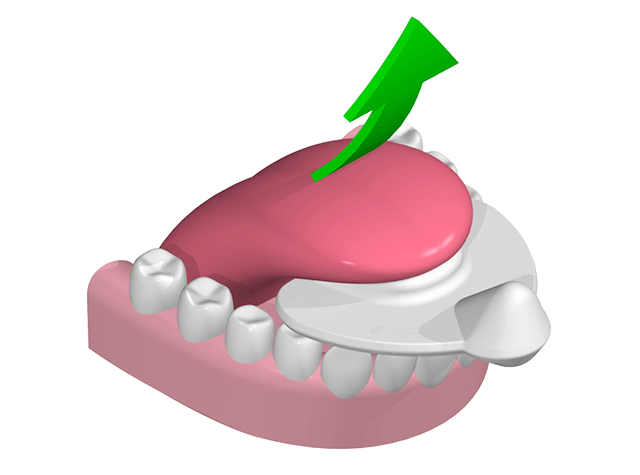In the case of swallowing disorders, a distinction is made between dysphagia and orofacial myofunctional disorders, which are often associated with misaligned teeth and jaws. As CMD experts, we will focus here exclusively on the swallowing disorders that underlie a myofunctional disorder. Myofunctional disorders (MFS) are complex disorders that affect the muscle functions in the mouth and face. These disorders can have far-reaching effects on the quality of life of those affected, as they impair basic functions such as speaking, swallowing and breathing. We explain what MFS is, the causes and symptoms behind it and how you can treat it sustainably.
What are myofunctional disorders?
Orofacial myofunctional disorder (MFS) is a condition characterized by dysfunction of the muscles in the mouth and face. This dysfunction impairs essential functions such as speech, swallowing and breathing and can manifest itself in a variety of symptoms. The muscles of the mouth and face play a crucial role in a number of basic human functions. These include the articulation of sounds, the act of swallowing, breathing and facial expressions. In MFS, the coordination and strength of these muscles is impaired, leading to a range of functional problems.
Causes of myofunctional disorders
The causes of myofunctional disorders are multi-layered and often interlinked, which makes their diagnosis and treatment complex. Here is an overview of the possible causes:
- Genetic factors
- Unfavorable feeding habits in infancy
- Unfavorable sucking habits
- Permanently obstructed nasal breathing
- Misaligned teeth and jaws Treatment with unfavorable orthodontic appliances
- Disorders during pregnancy or childbirth
These factors show that MFS can often be the result of a combination of genetic, environmental and behavioral influences. The complexity of these causes makes it necessary to take a holistic approach to the diagnosis and treatment of MFS, taking all potential contributing factors into account.
Symptoms of MFS
Myofunctional disorders present with a range of characteristic symptoms that affect various aspects of facial and oral function. These symptoms vary in intensity and manifestation and can have far-reaching effects on overall health and well-being. They can also occur as secondary effects of the primary symptoms of MFS. Here is a list of typical symptoms
- Flaccid muscle tension in the face
- Open mouth posture
- Mouth breathing
- Incorrect swallowing pattern, such as tongue thrusting
- Lisping
- Misaligned teeth
- Effects on posture
- Concentration problems and lack of motivation
The interaction of MFS with other bodily functions is of great importance. The dysfunction in the mouth and face can affect general health by affecting breathing and causing muscular tension in the neck and shoulders. These symptoms often require a multidisciplinary treatment strategy that addresses both the direct symptoms and their secondary effects.
Diagnostic process
The diagnosis of myofunctional disorders (MFS) is a careful and multi-layered process that is usually carried out by a team of professionals. This process typically begins with a detailed medical history of the patient, including childhood development and any family history. Particular attention is paid to symptoms that could indicate MFS.
The medical history is followed by a clinical examination, during which the patient's oral and facial muscles are closely examined. Attention is paid to signs of "slack" muscle tension, misalignment of the teeth, the resting position of the tongue and lips and general posture. In addition, specific functional tests are carried out to assess muscle activity and coordination in the mouth and facial area. These tests may also include checking the swallowing pattern, tongue mobility and lip strength.
Interdisciplinary collaboration with specialists such as speech therapists, dentists, orthodontists and ENT specialists is often required to assess all aspects of the disorder and make a comprehensive diagnosis.
Observation of the patient during everyday activities and interviews with parents and teachers can provide additional valuable information in children. Once all examinations and tests have been completed, the results are summarized and evaluated in order to obtain a complete picture of the disorder and create an individual treatment plan.
Quick help for MFS
The muscle forces generated during swallowing play an important role in the optimal development of the upper jaw. Improper swallowing function can lead to misalignment of the teeth and jaws, which can have long-term effects on jaw health.
Biochemistry and neurophysiology play an important role in the rehabilitation of swallowing function. The biochemical processes in the brain and body influence the function and communication of the nerve cells responsible for the swallowing process.
Memory plays a key role in swallowing rehabilitation. Through targeted training and repetition, new neuronal connections can be established to automate the desired normalization of the tongue position and correct swallowing process.
There are various treatment options for myofunctional disorders. In addition to speech therapy and dental or orthodontic treatment, there are products such as dental splints and tongue trainers. Our products Spoony Gloss and FroggyMouth, for the treatment of swallowing disorders and swallowing difficulties, program the unconscious adaptation of correct swallowing with recurring sequences. They can help to improve the muscle balance in the mouth and face area and thus reduce the symptoms of MFS.
Spoony Gloss - The foolproof dental splint
The dental splint with the triple effect for the treatment of swallowing disorders
Swallowing difficulties or swallowing disorders can already occur in early childhood. If left untreated, a poorly positioned tongue can lead to health problems such as mouth breathing, tongue protrusion or articulation errors.
Immediate help with myofunctional disorder: FROGGY
Der Froggymouth is a passive myofunctional therapy device developed to improve swallowing function. The FroggyMouth corrects atypical swallowing functions by helping to practice a new behavioral pattern in just 15 minutes a day.
At a glance
Myofunctional disorders are diseases characterized by a malfunction of the muscles in the mouth and facial area. They impair important functions such as speaking and swallowing. These disorders can arise for a variety of reasons, including genetic factors, unfavorable habits or structural abnormalities in the oral and facial area.
Typical signs of myofunctional disorders include mouth breathing, an incorrect swallowing pattern in which the tongue presses against or between the teeth in an atypical way, lisping and misaligned teeth. Other signs may include flaccid muscle tension in the face, difficulties in articulating certain sounds and altered facial aesthetics.
The treatment of myofunctional disorders is individualized and aims to restore correct muscle movement and function. It can include speech therapy, special exercises to strengthen the affected muscles, orthodontic measures and, in some cases, surgical interventions. Therapy is often interdisciplinary and involves specialists from various fields such as dentistry, speech therapy and ENT medicine. There are various medical aids that are used in the treatment of myofunctional disorders. The SpoonyGloss is a therapeutic aid that has been specially developed to promote correct tongue position and movement. The FroggyMouth is a type of splint that is inserted into the mouth. It was developed to correct the position of the tongue and promote a correct swallowing pattern. The splints are used to press the tongue against the palate.


